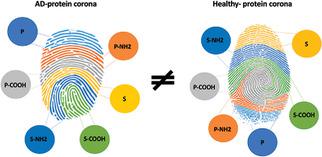当前位置:
X-MOL 学术
›
Adv. Healthcare Mater.
›
论文详情
Our official English website, www.x-mol.net, welcomes your feedback! (Note: you will need to create a separate account there.)
Analysis of the Human Plasma Proteome Using Multi‐Nanoparticle Protein Corona for Detection of Alzheimer's Disease
Advanced Healthcare Materials ( IF 10.0 ) Pub Date : 2020-11-09 , DOI: 10.1002/adhm.202000948 Claudia Corbo 1, 2 , Andrew A Li 3 , Hossein Poustchi 4 , Gha Young Lee 1 , Sabrina Stacks 1 , Roberto Molinaro 5 , Philip Ma 6 , Theo Platt 6 , Shahed Behzadi 1 , Robert Langer 7 , Vivek Farias 8 , Omid C Farokhzad 1
Advanced Healthcare Materials ( IF 10.0 ) Pub Date : 2020-11-09 , DOI: 10.1002/adhm.202000948 Claudia Corbo 1, 2 , Andrew A Li 3 , Hossein Poustchi 4 , Gha Young Lee 1 , Sabrina Stacks 1 , Roberto Molinaro 5 , Philip Ma 6 , Theo Platt 6 , Shahed Behzadi 1 , Robert Langer 7 , Vivek Farias 8 , Omid C Farokhzad 1
Affiliation

|
As the population affected by Alzheimer's disease (AD) grows, so does the need for a noninvasive and accurate diagnostic tool. Current research reveals that AD pathogenesis begins as early as decades before clinical symptoms. The unique properties of nanoparticles (NPs) may be exploited to develop noninvasive diagnostics for early detection of AD. After exposure of NPs to biological fluids, the NP surface is altered by an unbiased but selective and reproducible adsorption of biomolecules commonly referred to as the biomolecular corona or protein corona (PC). The discovery that the plasma proteome may be differentially altered during health and disease leads to the concept of disease‐specific PCs. Herein, the disease‐specific PCs formed around NPs in a multi‐NPs platform are employed to successfully identify subtle changes in plasma protein patterns and detect AD (>92% specificity and ≈100% sensitivity). Similar discrimination power is achieved using banked plasma samples from a cohort of patients several years prior to their diagnosis with AD. With the nanoplatform's analytic ability to analyze pathological proteomic changes into a disease‐specific identifier, this promising, noninvasive technology with implications for early detection and intervention could benefit not only patients with AD but other diseases as well.
中文翻译:

使用多纳米粒子蛋白电晕分析人类血浆蛋白质组以检测阿尔茨海默病
随着受阿尔茨海默病 (AD) 影响的人口增长,对无创且准确的诊断工具的需求也在增加。目前的研究表明,AD 的发病机制早在临床症状出现前几十年就开始了。纳米颗粒 (NPs) 的独特特性可用于开发用于 AD 早期检测的无创诊断方法。NPs 暴露于生物流体后,NP 表面会被生物分子的无偏但选择性和可重复的吸附改变,通常被称为生物分子电晕或蛋白质电晕 (PC)。血浆蛋白质组在健康和疾病期间可能会发生不同变化的发现导致了疾病特异性 PC 的概念。在此处,在多 NPs 平台中围绕 NPs 形成的疾病特异性 PC 用于成功识别血浆蛋白模式的细微变化并检测 AD(>92% 特异性和 ≈100% 灵敏度)。使用来自一组患者在 AD 诊断前几年的储存血浆样本可以获得类似的区分能力。凭借纳米平台将病理蛋白质组学变化分析为疾病特异性标识符的分析能力,这种有前途的非侵入性技术对早期检测和干预有影响,不仅可以使 AD 患者受益,还可以使其他疾病患者受益。
更新日期:2020-11-09
中文翻译:

使用多纳米粒子蛋白电晕分析人类血浆蛋白质组以检测阿尔茨海默病
随着受阿尔茨海默病 (AD) 影响的人口增长,对无创且准确的诊断工具的需求也在增加。目前的研究表明,AD 的发病机制早在临床症状出现前几十年就开始了。纳米颗粒 (NPs) 的独特特性可用于开发用于 AD 早期检测的无创诊断方法。NPs 暴露于生物流体后,NP 表面会被生物分子的无偏但选择性和可重复的吸附改变,通常被称为生物分子电晕或蛋白质电晕 (PC)。血浆蛋白质组在健康和疾病期间可能会发生不同变化的发现导致了疾病特异性 PC 的概念。在此处,在多 NPs 平台中围绕 NPs 形成的疾病特异性 PC 用于成功识别血浆蛋白模式的细微变化并检测 AD(>92% 特异性和 ≈100% 灵敏度)。使用来自一组患者在 AD 诊断前几年的储存血浆样本可以获得类似的区分能力。凭借纳米平台将病理蛋白质组学变化分析为疾病特异性标识符的分析能力,这种有前途的非侵入性技术对早期检测和干预有影响,不仅可以使 AD 患者受益,还可以使其他疾病患者受益。


























 京公网安备 11010802027423号
京公网安备 11010802027423号